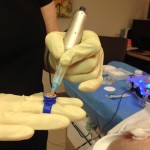 Here is an article and radio link to a story I agreed to in 2014. It was at the time of my nipple tattoo, yes I said “nipple” and “tattoo”. I’ve learned so many women don’t know about what their surgical options are and they don’t understand the process of breast reconstruction. It pays to know your options and the pros and cons of each. Ladies in your 20’s and 30’s, listen up. Trust me, this conversation is just starting!
Here is an article and radio link to a story I agreed to in 2014. It was at the time of my nipple tattoo, yes I said “nipple” and “tattoo”. I’ve learned so many women don’t know about what their surgical options are and they don’t understand the process of breast reconstruction. It pays to know your options and the pros and cons of each. Ladies in your 20’s and 30’s, listen up. Trust me, this conversation is just starting! Diane – who still hasn’t told people in her office about her breast cancer or surgeries – has gotten very used to talking about her nipples.

UT Southwestern Medical Center Plastic surgeon Dr. Nicholas Haddock talks with his patient, Diane, about the final stage in her breast reconstruction, the nipple tattoos.
“Let’s get over it, we have breasts. And you know what, we have nipples too,” she says. “The icing on the cake is the nipple tattoo.”
The Decision
In 2013, Diane found out she had breast cancer, and at 56 decided to have both breast removed – a double mastectomy.
For a while, she wore prosthesis. But she didn’t feel normal. Still, she says plastic surgery was a bit scary.
“I used to have such a bad opinion of plastic surgery,” Diane says, “Because to me it was the big lips, and the boobs and the Botox (…) but you know what? I remember the day I came in, Dr. Haddock took the bandages off, ran over to the mirror and I said, I’m starting to feel normal again.”
Not all women who have a mastectomy opt for breast reconstruction, although rates have gone up in the past decade. The women who do choose reconstruction have options that weren’t available to their mothers or grandmothers.
A Delicate Surgery
Dr. Nicholas Haddock, Diane’s plastic surgeon at UT Southwestern Medical Center, used a technique called deep inferior epigastric perforators (DIEP flap). It involves taking the patient’s own excess tissue to form the breasts, rather than using implants – which sometimes have to be replaced.
“It’s a lot like a tummy tuck,” Haddock explains. “If you had a tummy tuck that’s the tissue we usually remove, but in the tummy tuck we throw it away. In this situation instead I find those tiny blood vessels, bring it up to the chest and I plug those blood vessels into the chest.”
It’s a delicate surgery, reconnecting blood vessels that measure 2.5 millimeters, about the tip of a crayon. When Haddock finishes, a patient has both a breast, and skin in the form of a circle that acts as the areola.
The next step is making that lump of skin look like a nipple.
The Tattoo

The inks and circle stencil template used to create realistic looking nipples.
While some women go to tattoo artists not associated with a medical facility, Diane chose to have her nipples tattooed at the UT Southwestern clinic where her plastic surgery was done.
Stacey Burden, one of the aestheticians trained to give women who’ve lost their breasts to cancer new nipples, says this tattoo is more superficial than a traditional tattoo.
“And our color palette is considerably different,” Burden points out. “More flesh tones and natural colors.”
The tubes of ink look like lip gloss or concealer. The pinks and browns have names like “Princess,” “Chocolate truffle,” and “Sinnamon.”
Burden starts with a larger 11-pronged needle to give general color, and twenty minutes later moves on to detail work, shading and adding tiny bumps called Montgomery glands.
“The first time I did a tattoo by myself,” Burden says, “the patient stood up and admired herself in the mirror and she looked perfect. And she cried and I cried.”
A Personal Decision
To some, the nipple tattoo may sound excessive, but Dr. Haddock says it’s part of the recovery process. Stacey Burden, an Aesthetician with UT Southwestern Medical Center, prepares the ink to tattoo Diane’s nipples.
If mastectomy is covered by insurance, which it is for Diane, breast reconstruction – including the tattoo – is included. Just as insurers are recognizing the procedure, Haddock says tattoo artists and aesthetician are stepping up their game.
“In the past it might just be one solid color,” Haddock says, “and then it just looks like a cookie on someone’s breast. Whereas now, at least our tattoo artist is doing definition, creating shadow for the nipple, creating Montgomery glands, and some of the normal aspects of a normal nipple.”
Diane says it’s a very personal choice.
“My point is, reconstruction is out there and if women are not told this by their breast surgeon, it’s like they’re choosing from a menu that’s been partially redacted,” she says. “My view is you get all the facts together and then you make a decision.”
For Diane, the nipple tattoo is the last step in her physical recovery. A final detail that completes the picture.




